Fully Designed Custom Bjj Gi's
The **kimono gi** in Brazilian Jiu-Jitsu (BJJ) is a fundamental piece of gear, integral to both the practice and competition of the martial art. Originally derived from traditional Japanese martial arts, the gi used in BJJ is designed for durability, comfort, and functionality. Typically made from a robust cotton or a cotton-polyester blend, the gi consists of a jacket, pants, and a belt, each of which plays a specific role in training and competition.
The **jacket** is the most recognizable component, featuring a thick, often reinforced fabric that can withstand the intense grappling and pulling characteristic of BJJ. The jacket includes a collar, which is not just for aesthetics but serves as a grip point during rolls and matches, adding a strategic element to the game. High-quality gis are stitched with precision to ensure longevity, often including triple-reinforced seams and strong lapels to prevent wear and tear.
The **pants** of the gi are similarly constructed for durability, made from a lighter, yet sturdy material compared to the jacket. They are typically reinforced at the knees and sometimes at the shins to handle the friction and stress from the grappling that occurs during practice. An elastic waistband, often supplemented with a drawstring, ensures a secure fit and allows for a range of movement.
The **belt** represents rank and skill level, with color changes indicating progression through the ranks. Each belt signifies a practitioner's dedication, skill, and time spent mastering techniques.
In BJJ, wearing the gi is not just about tradition but also about enhancing technique and control. The fabric allows for grips and holds that are not possible in no-gi BJJ, making the gi a critical component in developing a versatile grappling game. Whether for training or competition, the kimono gi is essential for practicing BJJ effectively and authentically.




